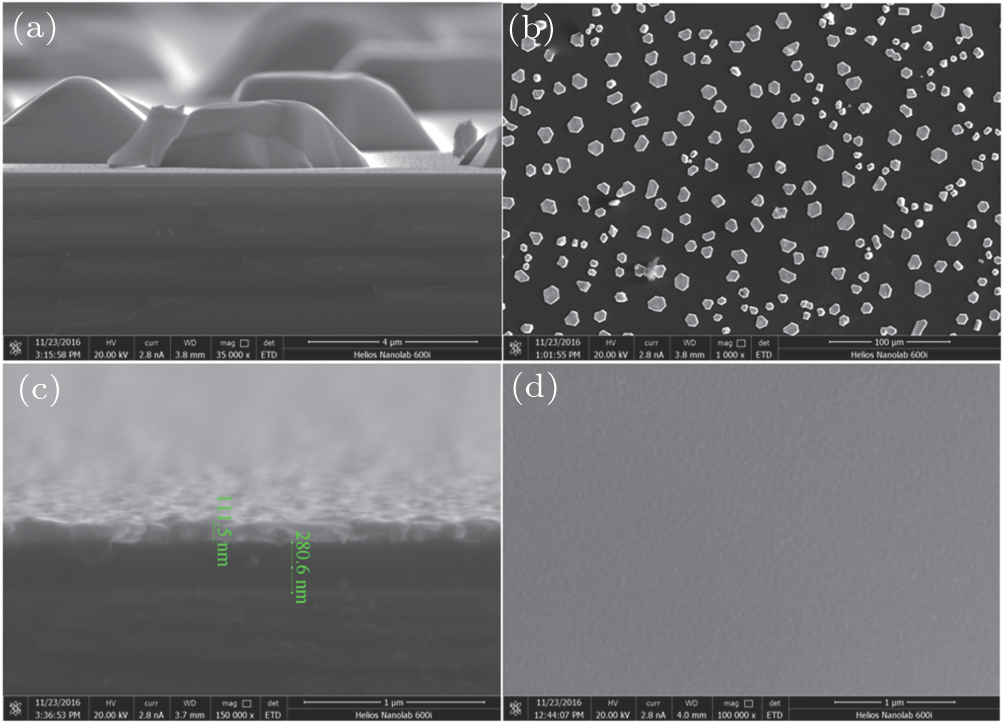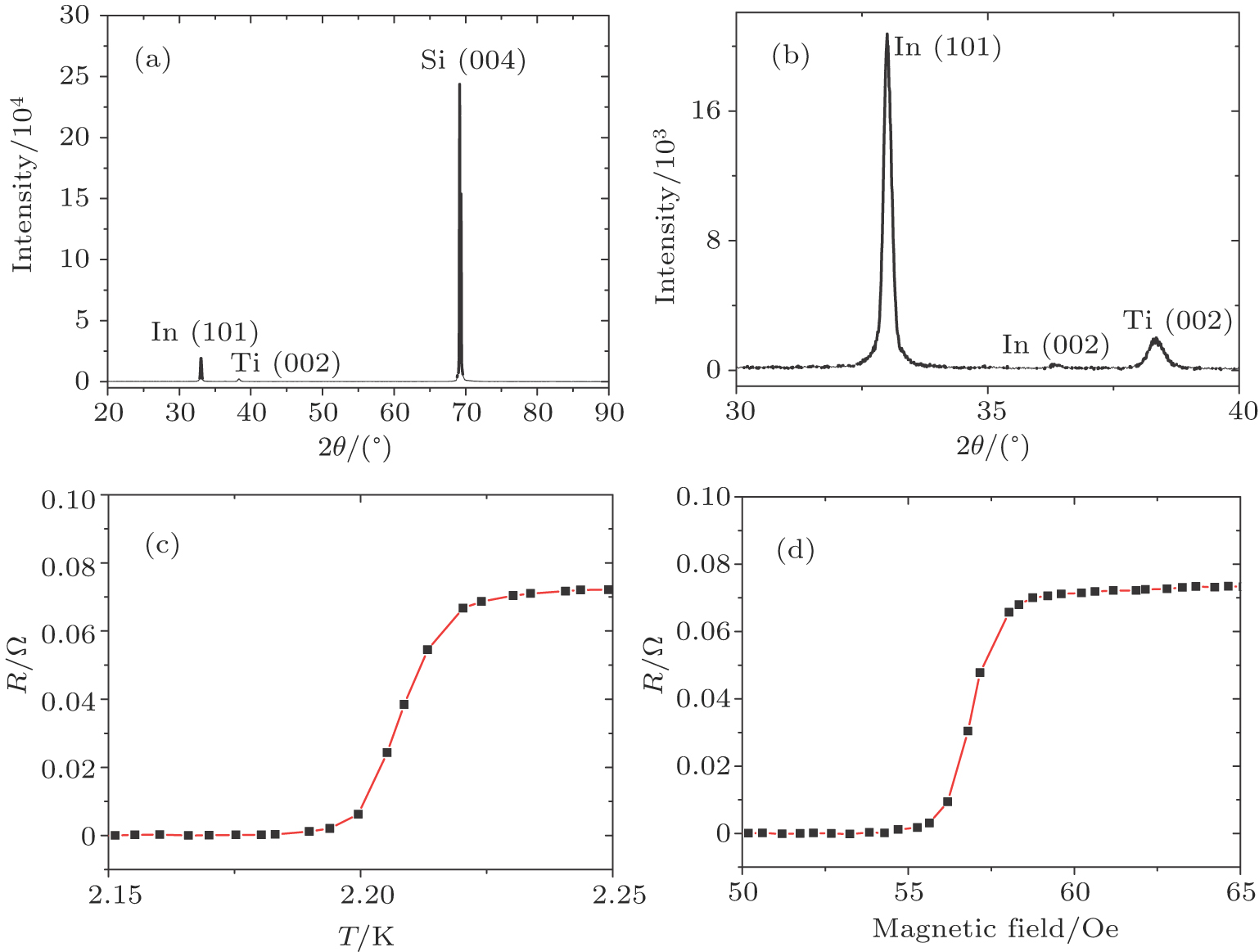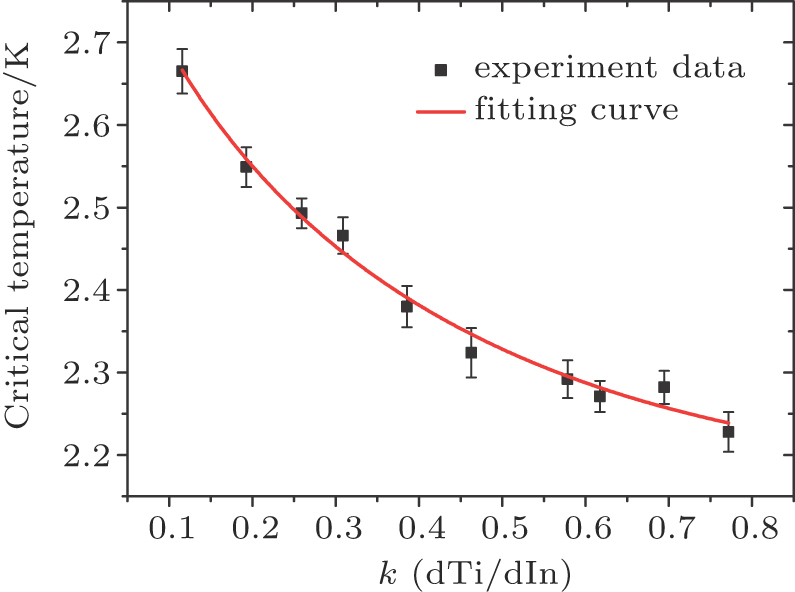† Corresponding author. E-mail:
Bilayer superconducting films with tunable transition temperature (Tc) are a critical ingredient to the fabrication of high-performance transition edge sensors. Commonly chosen materials include Mo/Au, Mo/Cu, Ti/Au, and Ti/Al systems. Here in this work, titanium/indium (Ti/In) bilayer superconducting films are successfully fabricated on SiO2/Si (001) substrates by molecular beam epitaxy (MBE). The success in the epitaxial growth of indium on titanium is achieved by lowering the substrate temperature to −150 °C during indium evaporation. We measure the critical temperature under a bias current of 10 μA, and obtain different superconducting transition temperatures ranging from 645 mK to 2.7 K by adjusting the thickness ratio of Ti/In. Our results demonstrate that the transition temperature decreases as the thickness ratio of Ti/In increases.
A transition edge sensor (TES) is a superconducting thin film biased in the transition region from the superconducting to the normal state, and serves as a sensitive thermometer that relies on the steep resistive transition of a superconducting material. Because of its high thermal sensitivity, it has wide applications in many areas, including single photon detectors from near-infrared to γ-ray, cosmic microwave background bolometers, and dark matter detectors.[1–15] The Tc of a bilayer superconducting thin film system could be tuned in a well controlled way by just tuning the thickness ratio of the two elements. Many bilayer systems, such as Mo/Au, Mo/Cu, Ti/Au, and Ti/Al systems,[1,11,16–21] have been chosen for fabricating the TESs.
Two techniques are in common use for depositing the high-quality bilayers: (i) e-beam evaporation and (ii) sputtering deposition. While in principle the fabrication of bilayer thin films should be quite straightforward, in practice its reproducibility remains a significant challenge, because it is difficult to control and disentangle in the individual contributions (strain, crystalline structure, contamination) in the above mentioned fabrication process. The state-of-the-art molecular beam epitaxy (MBE) technique offers a better option in the fabrication of bilayer thin films. During the MBE growth, the deposition rate can be monitored by quartz crystal micro-balance (QCM) and controlled within an accuracy of less than 0.01 nm/s. In the ultra-high vacuum (UHV) environment (≈ 1.0 ×10−10 mbar, 1 bar = 105 Pa), by appropriately controlling the substrate temperature and deposition rate, the reproducibility of the quality of the bilayer thin films could be guaranteed by the MBE technique.
In this work, we study the superconductivity of a new bilayer system, i.e., Ti/In thin film, aiming at developing a new TES. Theoretically, Tc of the Ti/In bilayer can be tuned between 390 mK (Tc of Ti bulk) and 3.4 K (Tc of indium bulk), where the Ti layer serves as the normal metal. We fabricate Ti/In bilayers by MBE to ensure the cleanliness of the interface and controllable thickness ratio. We successfully tune the Tc of Ti/In bilayer thin films from 645 mK to 2.7 K by adjusting the thickness ratio. The lowest Tc (645 mK) in our work is a little higher but also comparable to the results of the Al/Ti bilayer in Refs. [1] and [11] whose lowest Tc is around 540 mK. This implies that it is possible for our sample to be used as TES bolometers for millimeter wave and submillimeter wave astrophysics.
In order to study the superconductivities of Ti/In superconducting thin films, various thickness ratios of Ti/In were primarily deposited on 300-nm SiO2 on a ⟨100⟩ monocrystalline silicon substrate. The Ti/In films grew on a molecular beam epitaxial apparatus at a base pressure better than 1.0 × 10−10 mBar. High-purity indium (5 N) and titanium (5 N) were used for the growth. The temperature of the indium and titanium sources were kept at 750 °C and 1610 °C, respectively. For the growth of titanium film, the substrate was kept at 80 °C, while it was at −150 °C for the indium film growth. The detailed optimized growth conditions are listed in Table
| Table 1.
In/Ti film production parameters. . |
Scanning electron microscopy (SEM) was performed with an energy dispersive spectrometer (EDS) to characterize the surface morphology and the element compositions of the grown thin films. A physical property measurement system (PPMS) was used to study the superconductivities of the thin films.
The growth temperature is a critical parameter which can affect the quality of the film grown by MBE. The temperature affects the adhesion coefficient, growth rate, background impurity density, doping conditions, surface morphology, and interface between different epitaxial layers. The experiments were carried out under different temperature conditions.
Figures
We refer to the first successfully fabricated superconducting bilayer Ti/In film as sample #1, in which the indium layer is deposited at low temperature (−150 °C). The thickness values of titanium and indium layers are 100 nm and 130 nm, respectively. Figures
Figures
To study the manipulation of the transition temperature ratio of Ti/In (k), a series of Ti/In bilayer samples with various thickness ratio is fabricated and their transport properties are characterized systematically and shown in Fig.
Figure
In our work, dS = 129.6 nm. We define k = dN/dS = dN/129.6. It is assumed that titanium is a normal metal when temperature is above 390 mK, which is the Tc value of the titanium bulk, and that the other constant terms appear in the empirical formula (
To check the validity of the above model (Eq. (
Superconducting Ti/In bilayer thin films are successfully fabricated on SiO2/Si (001) substrate. The key issue for the growth process of the indium layer is to keep the substrate at a low temperature of −150 °C. Based on the proximity effect, the transition temperature Tc and the critical magnetic field of the Ti/In film are manipulated continuously by changing the thickness ratio k of the Ti/In layer. An empirical relationship between Tc and k based on the BCS theory is adapted to qualitatively explain the observed results. The validity of the empirical relationship is also checked experimentally, which implies the vast possibilities of manipulating the Tc of the Ti/In bilayer system, or other superconducting/normal layer systems by proximity effects. More researches on tuning the Tc of the Ti/In bilayer to even lower temperature and the possible application to practical TES sensors are under way.
| [1] | |
| [2] | |
| [3] | |
| [4] | |
| [5] | |
| [6] | |
| [7] | |
| [8] | |
| [9] | |
| [10] | |
| [11] | |
| [12] | |
| [13] | |
| [14] | |
| [15] | |
| [16] | |
| [17] | |
| [18] | |
| [19] | |
| [20] | |
| [21] | |
| [22] | |
| [23] | |
| [24] | |
| [25] | |
| [26] |






